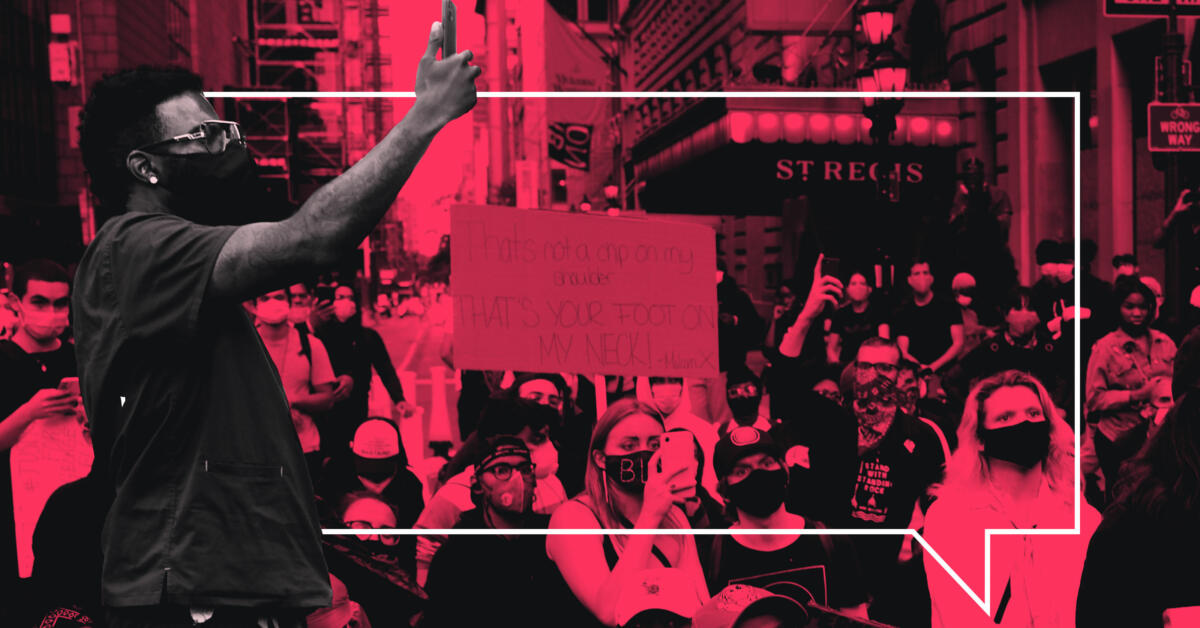- cross-posted to:
- brainworms@lemm.ee
- cross-posted to:
- brainworms@lemm.ee
Simple steps to take before hitting the streets
Signal & WhatsApp are not secure enough. Meta/Facebook regularly give data & metatadata to the cops & Signal is centralized & not self-hosted by your crew so while messages are encrypted, the metadata still isn’t. If you must use Signal, I would pick Molly as an Android client since you can a) encrypt the messages under a separate password for storage on seizure & b) you can use the UnifiedPush version to make sure your notification metadata isn’t going thru Google’s Firebase servers. Protests are the ideal place for Briar as it is works via mesh net so internet & SIM cards are not required (but years ago wden I tried it, the app was a major battery drainer).
the metadata still isn’t.
That doesn’t quite work in the case of Signal
The only data that they have, based on transparency reports and dissections of their source code, is the time you created your account and last connected to the servers.
Messages themselves are essentially only relayed, with sealed sender, and anything that would be actually useful to identify who was at a protest and who wasn’t encrypted.
Things like, e.g when messages arrive at the server would have to be monitored live on compromised servers, which reasonably unless you assume* it is wiretapped already prior to a protest, isn’t realistic.
*: of course, I am saying this because making an assumption and portraying it as truth (e.g assuming something is already wiretapped based on no evidence at all) is not the smartest of moves when it comes to threat modeling…especially if you wanna stay sane whilst having a threat model
With the right intel you could piece back some of the pieces, especially with some pieces from other sources, with just that metadata. With metadata, it’s about putting together lots of sources to see the picture clearly which is why Facebook bought WhatsApp for just the metadata (& address book). The thing is that you, can skip Signal & you will still have several free software messaging alternativ where nothing is on a US-based server where they can subpoena.
But that’d already entail control over the whole Signal AWS in- and egress as well as any VPN you may be using and/or your local ISP. And then you still have to prove the actual link to the natural person. At that point we’re speaking of a threat level assuming the US DoD as adversary. While not impossible, I think if you’re willing to pick that kind of fight, you’re clever enough not to rely on Signal (or most digital communication).
Signal is not WhatsApp, there aren’t a lot of data points linking your communications to end points in the same way Meta does link them.
Just leave your phone at home, and bring a Digital camera, and few SD Cards … Oh, wait… < insert company name here > makes Cameras that spy on you… nevermind…
maybe we should hire a fast sketching artist to draw police brutality … What.!.. your pencil can track you now… come…ooooonnn
Burner phone to anything that requires communication. Erase metadata of anything that will be shared and uploaded online.
Burner phones are a strange concept. If you want to store sensitive data on it, you shouldnt use some cheap android phone or even a dumbphone without encryption support.
All Androids since 9 at least have been encrypted by default as long as you have a lock screen enabled. Doesn’t matter if its cheap, it is there.
All Android phones have Google malware installed by default, as system apps, which means those apps can do whatever they want.
So every piece of data you put on there is possibly tracked and collected.
Then there are 2 more problems
- the software is proprietary and cannot be externally wiped clean
- the software is outdated
This makes it vulnerable to Pegasus attacks and others. There are tons of secure practices to avoid getting it, like LTE-only, HTTPS only, encrypted and trustworthy DNS, sandboxed processes, blocked javascript execution from unknown websites…
But still if the phone is outdated there are unpatched and publicly known security issues. Just spamming them at all phones is likely to succeed as so many people run vulnerable versions, as vendors suck.
Then if you have pegasus, the only way for security is to reflash the A/B partitions, both. Factory reset is not secure as it will keep what is already in the system partitions.
The firmware is protected and signed by the vendors, so it is likely clean.
But Pegasus installs itself to the phone storage.
If you A cant obtain factory images or B cant flash the phone at all, you cannot wipe it clean.
So a good activism phone needs
- trustworthy and minimal system apps / stock software
- modern software updates
- possible to reflash whole device externally
- nice to have: ability to verify checksum of system partition, like GrapheneOS Attestation
This makes them poorly pretty expensive. I think a slightly outdated GrapheneOS phone is okay though.
Then get a burner pixel 3a and install grapheneOS or DivestOS
I think 3a is already too old. I think 4a is a better minimum, but this is still insecure of course.
Most of that is solved by installing a ROM that’s not user hostile, keeping it updated of course, and using the phone strictly as a purpose specific device.
That means you run a trusted VPN on it so HTTP/S and DNS concerns go out the window.
Sandboxed processes, blocked JS? Fine if you only install what’s necessary and don’t use the web browser. JS blocking is not a huge hurdle though, ublock does it with just 2 clicks.Then if you have pegasus, the only way for security is to reflash the A/B partitions, both. Factory reset is not secure as it will keep what is already in the system partitions.
That’s right but I don’t think that this is enough. If the Pegasus malware (package) really is able to do that many things, it’s a walk in the park for it to modify any of the partitions, including that which contains the modem, or just data like the modem’s IMEI and MAC addresses.
In the cause I would either restore a backup of all partitions, or throw the phone away (not literally).The firmware is protected and signed by the vendors, so it is likely clean.
Except if they patched the verification mechanisms of the OS.
Also, the firmware may be protected, but what about data partitions which are read by vulnerable software.This makes them poorly pretty expensive. I think a slightly outdated GrapheneOS phone is okay though.
Are you sure? My 6 years old phone still receives LOS updates
Not sure if VPN eliminates all risks with 2G and 3G, maybe it does.
Sandboxing, javascript
Vanadium has sandboxing but its javascript blocking is useless (no granular control)
Mull has no process isolation at all, but support for UBO and Noscript. Bad situation
it’s a walk in the park for it to modify any of the partitions
These cannot be written without TPM verification or stuff, ask GrapheneOS devs about that, I dont know. The firmware signing is required, the verification will not be done inside the OS, that would be totally flawed.
If they have the firmware signing keys, they can fuck you. If they dont, they can only write to the system partition, and Attestation can see that.
Reading data has nothing to do with that. They likely can, but that doesnt matter.
My 6 years old phone still receives LOS updates
This will not include firmware and likely even the kernel.
Not sure if VPN eliminates all risks with 2G and 3G, maybe it does.
It doesn’t, but probably even on modern phones it only does if you explicitly set it to only use 4G but nothing below that.
Mull has no process isolation at all, but support for UBO and Noscript. Bad situation
If you only visit known reputable websites it’s probably not really a problem, but also, I think there are chromium browsers that have addons. Not sure though if there’s one that besides that also has the security patches.
These cannot be written without TPM verification or stuff
I doubt that it couldn’t be written, I believe TPM can only verify its contents and make the phone refuse to boot if it doesn’t agree on the authenticity of the partition contents.
However it’s also a question which partitions are checked that way: only the system partition? Or more? Probably not all, because they can’t verify e.g. the main user data partition, because it’s ever changing contents were never signed by the manufacturer. There’s a few dozens of partitions usually so this is not trivial to answer.the verification will not be done inside the OS, that would be totally flawed.
Yes, verification is done by one of the bootloaders. At least partly, the OS and maybe other layers must be doing it too, just remember why Magisk had a feature to hide it’s processes and the controlling app itself from select system services and other apps.
Reading data has nothing to do with that. They likely can, but that doesnt matter.
Didn’t mean that. I meant writing data that is later being read by other important system software that is vulnerable to specially crafted quirks in that data.
The point is not cheapness but that you don’t care about the future of that phone. It’s only a tool for the protest, if it lasts longer that’s good but you expect it to get confiscated and never given back, you don’t care what cops did with it if you get it back, it does not have data you need in your daily life or anything irreplaceable, and you’re not really afraid that it gets destroyed by accident or maliciously.
Yes that is one definition.
But what if you get it back? Or if you just keep it?
There is a chance that you have Pegasus on there, and I wouldnt want a phone without the detection of this.
GrapheneOS can likely detect pegasus with their Attestation and if you have it, use an external device to reflash it.








